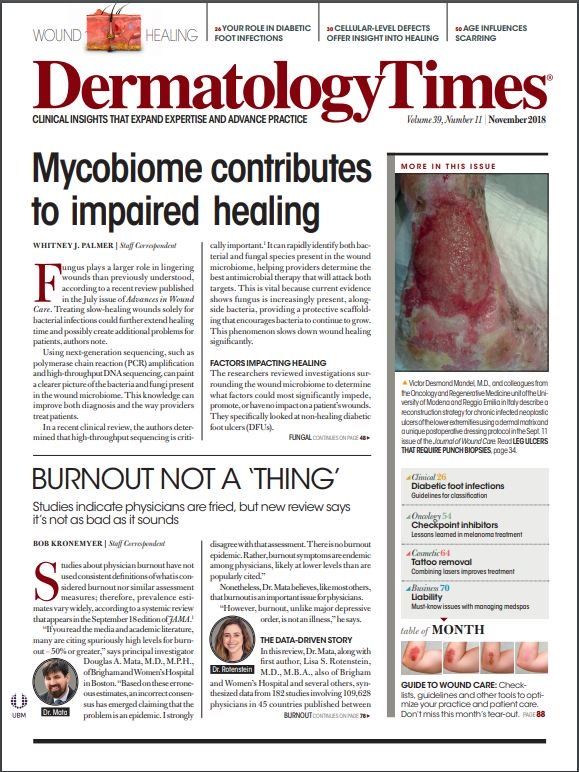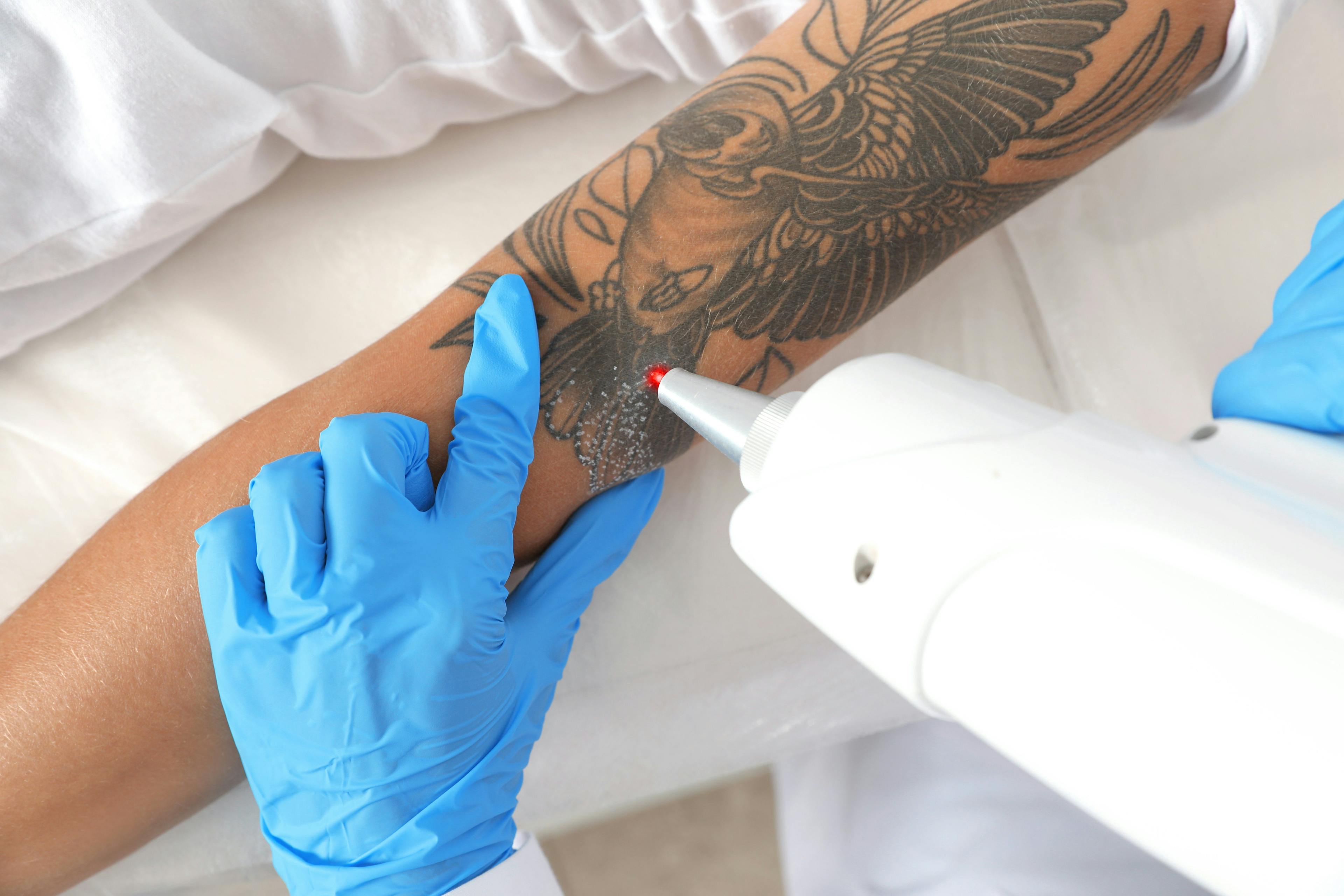- Acne
- Actinic Keratosis
- Aesthetics
- Alopecia
- Atopic Dermatitis
- Buy-and-Bill
- COVID-19
- Case-Based Roundtable
- Chronic Hand Eczema
- Chronic Spontaneous Urticaria
- Drug Watch
- Eczema
- General Dermatology
- Hidradenitis Suppurativa
- Melasma
- NP and PA
- Pediatric Dermatology
- Pigmentary Disorders
- Practice Management
- Precision Medicine and Biologics
- Prurigo Nodularis
- Psoriasis
- Psoriatic Arthritis
- Rare Disease
- Rosacea
- Skin Cancer
- Vitiligo
- Wound Care
Publication
Article
Dermatology Times
Surgical treatment for basal cell carcinomas still the best bet
Author(s):
There are many non-surgical treatments for basal cell carcinomas, but a physician reporting at EADV last week said new treatments should be compared against surgery, which has the highest cure rate and lowest rate of recurrence.
PARISâBasal cell carcinoma is the most common form of skin cancer and its incidence is increasing worldwide. As a rule, surgery is the first choice for basal-cell carcinoma. However, for patients with low-risk superficial basal cell carcinomas, non-surgical medical therapy may be appropriate, said Eduardo Nagore, M.D. during a presentation at the European Academy of Dermatology and Venereology Congress last week in Paris.
Dr. Nagore, of the Instituto Valenciano de OncologÃa in Spain, led a discussion about non-surgical therapeutic modalities for low-risk basal cell carcinomas1.
Non-surgical therapy is suited to tumors around the eye, nose, mouth or ear where relapse can be devastating. The updated European guidelines for basal cell carcinomas treatment recommends imiquimod, photodynamic therapy, 5-fluorouracil, and cryosurgery as first-line treatments for superficial basal cell carcinomas, and all but imiquimod as second-line treatments for nodular basal cell carcinomas.
“While many people seem to be using non-surgical techniques, there has been a lack of good quality results from randomized controlled clinical trials,” Dr. Nagore siad. Any new treatment should be compared against surgery, which has the highest cure rate and lowest rate of recurrence, he said.
Dr. Nagore described the recent results from comparative randomized controlled trials.
IMIQUIMOD
Imiquimod is an immune response modifier that promotes the Th1 response. It activates the innate immune system enhancing cytotoxic T-cell activation, NK cell stimulation, and pro-apoptotic activity.
Its efficacy has been demonstrated in several trials and the optimal efficacy-safety balance is five times per week for six weeks. A clinical cure rate of 80-90 percent and a pathological cure rate of around 85 percent has been reported2. There was a five-year sustained clearance in 85-87 percent. Five-year results of a large-scale trials reported imiquimod cure rates of 91 percent for superficial basal cell carcinoma and 85 percent for nodular basal cell carcinomas3. The recurrence of superficial basal cell carcinoma was eight (84 percent success) and that of nodular basal cell carcinomas was six (81 percent success), and the overall difference in treatment success (surgery/imiquimod) was around 15 percent.
Imiquimod is generally well tolerated and inflammatory reactions are not necessarily related to treatment outcomes. “The immune response is very individual. There’s not a one-on-one relationship between the reaction and the outcome,” he said. Rest periods do not affect the outcome.
PHOTODYNAMIC THERAPY (PDT)
PDT is a three-step procedure that involves application of a topical photosensitizer (such as aminolevulinic acid or methylaminolevulinate) and light exposure (LEDs/lasers). Activation of the photosensitizer by illumination causes a release of reactive oxygen species and consequent destruction of the target tissue by apoptosis or necrosis. Two treatment sessions with a one-week interval are recommended.
PDT is generally well tolerated. Side effects include tingling, burning and pain during illumination, and erythema and edema after treatment. For superficial basal cell carcinomas, efficacy can be reduced by the presence of pigment. A clearance rate of 79-97 percent at three months was reported in a recent systematic review4.
“Imiquimod has a better efficacy, but some dermatologists prefer PDT,” Dr. Nagore said. PDT is quicker, only involving single treatments. Some patients prefer a fast resolution of the problem, whereas others may prefer to wait to have a better cosmetic outcome.
5-FU
On entering the cell, 5-FU is converted into active metabolites that interfere with normal nucleic acid functioning. This means that 5-FU can achieve targeted cell death of rapidly proliferating cells with a minimal effect on normal skin cells.
Published in early 2018 one clinical trial of 601 patients compared the efficacy of imiquimod cream (5 percent once daily for five consecutive days/week for six weeks), methylaminolevulinate PDT (two treatments, one-week interval), and 5-FU cream (twice daily for 4 weeks)5. This is the first and only study to report five-year recurrence rate data for 5-FU. Imiquimod was more effective than both PDT and 5-FU, and 5-FU was marginally superior to PDT. “5-fluoruracil could be considered as second-line therapy,” he said.
CRYOSURGERY
Cryosurgery induces localized frostbite, resulting in necrosis and tissue destruction. Liquid nitrogen is the most effective cryogen for clinical use, and effective removal requires temperatures of -40°C to -60°C. The general principle of cryosurgery is “freeze fast, thaw slow,” and repeated freeze-thaw cycles (recommended for facial basal cell carcinomas) increase effectiveness. Recurrence rates vary from 8-40 percent. “It could be considered as palliative treatment in cases not suitable for topical treatment,” Dr. Nagore said. Cryotherapy has been associated with delayed wound healing, non-precise tissue destruction, nerve damage and scars, plus more adverse effects are seen in patients with dark skin, Raynaud’s disease and diabetes.
“Until last year, there has been a lack of controlled trials for laser treatment for basal cell carcinomas,” Dr. Nagore said. A recent comparative trial of 240 patients with superficial basal cell carcinomas found that cryotherapy had an efficacy (cure rate at three months), cosmetic outcome, and patient satisfaction that was comparative to pulsed CO2 laser therapy6. Patient satisfaction of laser therapy was similar to that of surgery.
Cryotherapy applied to imiquimod refractory basal cell carcinomas seems to sensitize the tumor to the effect of the drug, thus reducing the percentage of patients who need surgery after an incomplete response to imiquimod. This was shown in a pilot study by Dr. Nagore and colleagues7 and in a phase three interventional study8. Further clinical research trials are required.
INGENOL MEBUTATE
Ingenol mebutate was reported to be a safe and efficient treatment for basal cell carcinomas in a phase two-A trial of 60 patients with optimal histological and pathological clearance at 0.05 percent9. Good clinical and dermatological clearance is seen after treatment once daily for two consecutive days9,10. Further research is required.
REFERENCES
1. Nagore, E. (2018). Non-surgical therapeutic modalities for low-risk basal cell carcinoma: Possibilities and risks, The 27th European Academy of Dermatology and Venereology Congress, Paris, France, 15th September, 08:00 - 08:20.
2. Roozeboom, M.H., Arits, A.H.H.M., Nelemans, P.J. and KellenersâSmeets, N.W.J. (2012). Overall treatment success after treatment of primary superficial basal cell carcinoma: a systematic review and metaâanalysis of randomized and nonrandomized trials. British Journal of Dermatology, 167(4), pp.733-756.
3. Williams, H.C., Bath-Hextall, F., Ozolins, M., Armstrong, S.J., Colver, G.B., Perkins, W., Miller, P.S., for Nodular, S.V.I. and Group, S.B.C.C.S.S. (2017). Surgery versus 5% imiquimod for nodular and superficial basal cell carcinoma: 5-year results of the SINS randomized controlled trial. Journal of Investigative Dermatology, 137(3), pp.614-619.
4. Collier, N.J., Haylett, A.K., Wong, T.H., Morton, C.A., Ibbotson, S.H., McKenna, K.E., Mallipeddi, R., Moseley, H., Seukeran, D., Ward, K.A. and Mohd Mustapa, M.F. (2018). Conventional and combination topical photodynamic therapy for basal cell carcinoma: systematic review and metaâanalysis. British Journal of Dermatology.
5. Jansen, M.H., Mosterd, K., Arits, A.H., Roozeboom, M.H., Sommer, A., Essers, B.A., van Pelt, H.P., Quaedvlieg, P.J., Steijlen, P.M., Nelemans, P.J. and Kelleners-Smeets, N.W., 2018. Five-Year Results of a Randomized Controlled Trial Comparing Effectiveness of Photodynamic Therapy, Topical Imiquimod, and Topical 5-Fluorouracil in Patients with Superficial Basal Cell Carcinoma. Journal of Investigative Dermatology, 138(3), pp.527-533.
6. Zane, C., Facchinetti, E., Arisi, M., Ortel, B. and Calzavara-Pinton, P. (2017). Pulsed CO2 Laser Ablation of Superficial Basal Cell of Limbs and Trunk: A Comparative Randomized Clinical Trial With Cryotherapy and Surgical Ablation. Dermatologic Surgery, 43(7), pp.920-927.
7. Messeguer, F., SerraâGuillen, C., Echeverria, B., Requena, C., Sanmartin, O., Llombart, B., Guillen, C. and Nagore, E. (2012). A pilot study of clinical efficacy of imiquimod and cryotherapy for the treatment of basal cell carcinoma with incomplete response to imiquimod. Journal of the European Academy of Dermatology and Venereology, 26(7), pp.879-881.
8. Gaitanis, G. and Bassukas, I.D. (2014). Immunocryosurgery for non-superficial basal cell carcinoma: a prospective, open-label phase III study for tumours ≤ 2 cm in diameter. Acta Dermato-venereologica, 94(1), pp.38-44.
9. Siller, G., Rosen, R., Freeman, M., Welburn, P., Katsamas, J. and Ogbourne, S.M. (2010). PEP005 (ingenol mebutate) gel for the topical treatment of superficial basal cell carcinoma: results of a randomized phase IIa trial. Australasian Journal of Dermatology, 51(2), pp.99-105.
10. Izzi, S., Sorgi, P., Piemonte, P., Carbone, A. and Frascione, P. (2016). Successfully treated superficial basal cell carcinomas with ingenol mebutate 0.05% gel: report of twenty cases. Dermatologic Therapy, 29(6), pp.470-472.

Newsletter
Like what you’re reading? Subscribe to Dermatology Times for weekly updates on therapies, innovations, and real-world practice tips.




























